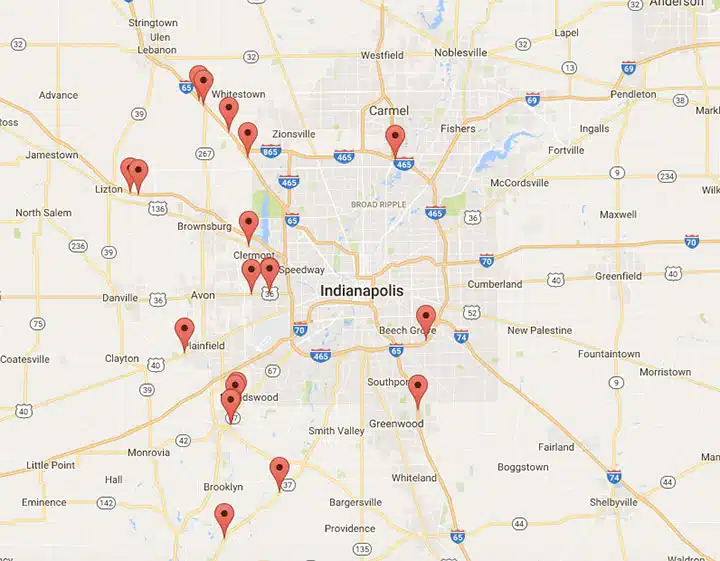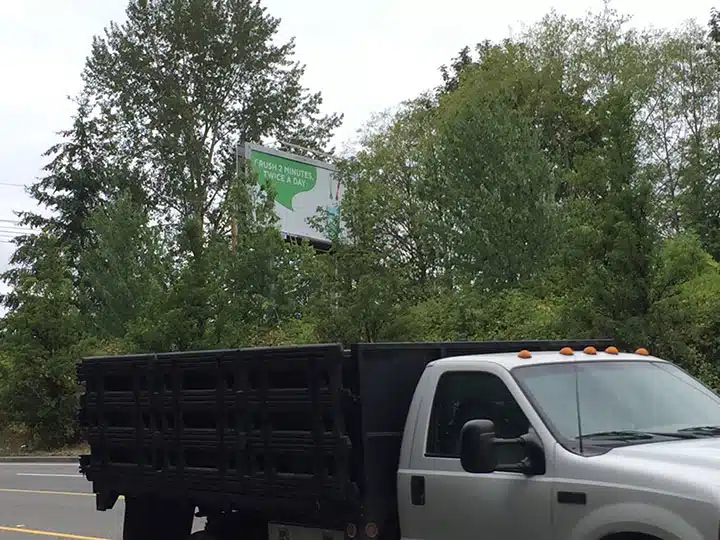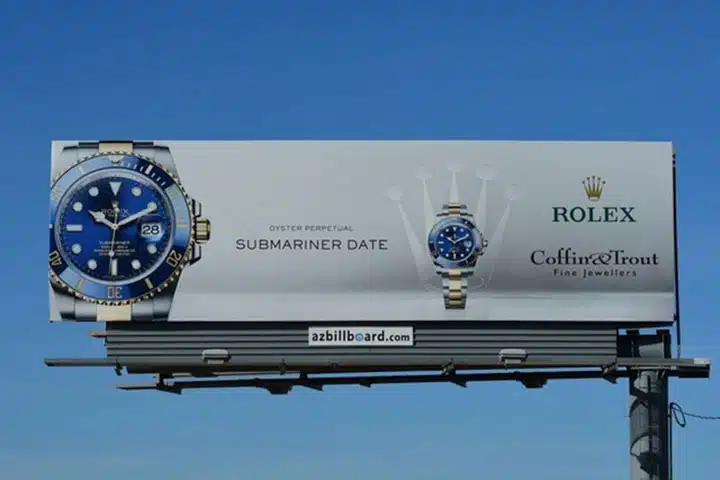How to Get the Most Out of Your Billboard Buy
A successful billboard campaign often involves buying multiple units — not just one lone sign. Below is a key strategy to maximize reach and impact:
- Buy multiple boards strategically. Billboards are static, but your audience is on the move. The most effective outdoor campaigns deploy several boards across key arteries where people live, work, and travel. This includes major interstates, surface streets, and entrance/exit corridors into a city.
- One client of ours buys boards along every major highway entering and exiting the top 25 U.S. markets. Retail clients often request placements within a 2-mile radius of a new store opening. These tactics create frequency, familiarity, and trust — especially in competitive or fast-moving markets.
- While a single board might work for a local business in a small town, it won’t cut it in dense urban areas. In big cities, message repetition across multiple high-traffic locations is what drives results.
Most billboard companies have a wide range of inventory throughout a city. Here’s an example from Indianapolis.

Buy Short-Term for Events, Long-Term for Awareness
Billboard campaigns are typically sold in four-week increments. Short-term buys — such as 4, 8, or 12 weeks — are ideal for promoting time-sensitive messages like concerts, movie releases, conventions, seasonal sales, or product launches. These are especially effective on digital billboards, where there’s no added production cost to update the creative.
Long-term placements (6–12 months) are best suited for location-based advertising and general brand awareness. These static boards act like visual anchors in high-traffic areas. National brands like Cracker Barrel and McDonald’s regularly buy long-term highway inventory to direct drivers to the nearest exit or service location.
The takeaway: Use short-term buys to spark urgency and buzz. Use long-term placements to build familiarity and stay top-of-mind — especially in areas with steady, year-round traffic.

Know What You’re Really Buying
- If you’re purchasing multiple boards as part of a broader campaign, this becomes especially critical. Not all billboards are created equal — and some are practically invisible to passing traffic. They may be blocked by trees, poles, street furniture, or even positioned at awkward angles behind buildings. These placements may technically count as impressions, but they deliver little real-world value.
- Before you sign off, ask your media buyer to provide visibility photos or maps for each board. Tools like Street View or drone footage can give you a realistic sense of exposure. Better yet, work with a provider that uses an independent verification service to confirm that your vinyl was properly installed and is viewable under normal driving conditions.
- This kind of diligence matters — especially if you’re running a time-sensitive campaign. A hidden board does nothing for brand awareness, product launches, or event attendance.
Can you spot the billboard?

Freshen the Message to Stay Relevant
- Consumers may tune out your billboard if they see the same message again and again. Message fatigue is real — especially for daily commuters. Additionally, vinyl can fade over time, particularly in sunny climates like California, Texas, or Florida. To maintain impact and visibility, it’s a smart move to update your creative every 12 weeks if you’re on a long-term contract.
- The exception to this rule is for professional service providers — such as lawyers, pest control, real estate agents, and banks. In those cases, repetition works in your favor. The goal is to be top-of-mind when someone suddenly needs your service. Not everyone needs a personal injury attorney today, but they’ll remember your name when the moment comes — if your board has been consistent.
- That said, swapping in new creative does come with a cost. Most billboard companies will charge you for the new vinyl printing and potentially the install labor. Budget for roughly $300–$500 per copy change. Plan ahead so your refreshes stay on schedule without surprises.
- Consider seasonal creative changes as well. A winter message might not resonate in summer, and a design that worked in March could feel stale by July. Even luxury brands like Rolex update their board art quarterly to align with product launches or seasonal promotions.
Brand campaign for Rolex Watch. Jewelers often change designs every 3 months.

Billboard Booking Timing by City
Billboard availability and booking lead time can vary significantly by market. Here’s what you can typically expect in some of the top U.S. cities:
- Los Angeles, CA: High-profile areas like Sunset Strip often require booking 2–3 months in advance, especially during film release or awards season.
- New York City, NY: Times Square and Midtown inventory can sell out 6 months ahead due to high demand year-round.
- Austin, TX: Billboard space books quickly around major events like SXSW and ACL — plan at least 3 months early for prime spots.
- Miami, FL: Inventory tightens during winter travel season and spring break, so booking 2–4 months ahead is smart.
- Las Vegas, NV: Convention-heavy weeks and concert residencies drive up demand — early reservations are key on the Strip.
Match Your Message to the Moment
One of the biggest advantages of digital billboards is flexibility. You can change your message in real time based on the time of day, day of the week, weather, season, or even local events — all without paying for new vinyl or reinstallation.
In a study conducted by Posterscope involving over 100,000 people, 60–80% of respondents said they prefer seeing ads that are relevant to their current context — like the weather, local sports games, or time of day. That means a coffee ad might work best during morning rush hour, while a fast food deal could shine in the afternoon or after dark.
Dynamic digital creative opens the door to smarter outdoor campaigns that change with your audience’s needs. Whether it’s reminding commuters of a Friday sale, showing sunglasses during a heat wave, or teasing a local team’s big game — matching the moment increases impact.
We’ll dive deeper into dynamic digital content strategy in an upcoming post.
FAQ
Q. When should I book a billboard campaign?
You should book your billboard 2–6 months in advance, especially if you’re targeting high-demand seasons or premium locations.
Q. Where can I buy billboard advertising?
You can buy billboard space through agencies like DASH TWO that work directly with billboard owners and media networks in every major market.
Q. Do billboard prices change by season?
es. Rates are often higher around major events (like the Super Bowl or summer holidays) due to increased demand.
Q. Can I still buy a billboard last-minute?
Sometimes. Last-minute availability is possible, but options may be limited and prices are usually higher.
Q. How long should I run a billboard campaign?
Most campaigns run for 4 to 8 weeks, but longer flights are recommended for brand awareness and saturation.


Thank you for the tips. I am now in the process of planning a billboard campaign for my company. We are a not-for-profit organization so we have to be really smart with our budget. Our main objective is to spread awareness but we’ll go with a short-term campaign on the month dedicated to our cause.
I’ve never thought that it makes such a difference whether you change your ads during a long-term campaign or not. I guess you’re right about sticking to the same ad if you’re advertising a professional service. After all, you want to build a recognizable brand. Changing your ads every month or so won’t help your potential clients remember you.
That’s a lot of helpful information there. I never gave it a lot of thought but the placement of the advertisement really is important. I wouldn’t want to spend thousands of dollars for a billboard just to have it hidden in the trees just like on that picture. The ad has to stand out and attract attention.